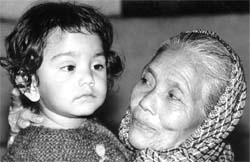Memories of grandma
 one of the most exciting discoveries in modern genetics concerns a phenomenon known as imprinting. In imprinting, the pairs of chromosomes that we inherit from our parents behave in an unexpected way. They show that they 'know' whether they have come from our mother or from our father. The reason this is unexpected is that beginning with the founding of the field by the Bohemian monk Gregor Mendel, well over 100 years of work in genetics had made us believe that no such thing could happen. An imprinted gene or imprinted chromosome in your body may be said to carry a memory of your mother or your father. Therefore, two persons who carry the same gene may display different consequences of possessing that gene if the gene came from one person's father but from the other person's mother.
one of the most exciting discoveries in modern genetics concerns a phenomenon known as imprinting. In imprinting, the pairs of chromosomes that we inherit from our parents behave in an unexpected way. They show that they 'know' whether they have come from our mother or from our father. The reason this is unexpected is that beginning with the founding of the field by the Bohemian monk Gregor Mendel, well over 100 years of work in genetics had made us believe that no such thing could happen. An imprinted gene or imprinted chromosome in your body may be said to carry a memory of your mother or your father. Therefore, two persons who carry the same gene may display different consequences of possessing that gene if the gene came from one person's father but from the other person's mother.
Quite apart from the intrinsic interest in the finding, what this implies is something astonishing.Namely, that how an individual fares in life - how an individual is assessed by evolution - may depend, not just on that person's genes, but also on the genes of his or her parents. Now, comes a finding that points to something even more surprising: the genetic makeup of one's grandparents too may play an important role in one's own life. The actual experiments have been carried out on mice by H D Morgan and colleagues at the University of Sydney, Australia (Nature Genetics , Vol 23, p314-318).
Morgan and his colleagues directed their attention to a well-known condition in mice known as agouti. Agouti mice have a yellow band near the tip of their body hair and this yellow, in combination with the usual grey pigmentation, gives a mouse its typical 'mousy' colour. A particular strain of agouti mice carries a piece of parasitic dna ( deoxyribonucleic acid) close to the agouti gene.
Interestingly, the parasitic dna comes from a 'retro-transposon': a piece of parasitic dna that began as a rna molecule and later got copied in reverse to give rise to dna. Thus, it behaves like a virus that belongs to the same class as the human immunodeficiency virus that is implicated in causing aids . Because of the presence of this retroviral dna , the agouti gene gets expressed in places where it should not be. The consequences are many: the mice develop a yellowish fur, get fat, tend to develop diabetes and also become prone to a variety of tumours.
Quite apart from causing the agouti gene to behave inappropriately, the retro-transposon also makes mice that are genetically identical, look different. One may appear yellowish, another black and a third, typically agouti-ish. And, in turn, the mice born to each of these three kinds of mothers end up looking different on the average, even though their genetic make-up is identical. This observation shows that imprinting must be at work.
The clincher comes now. The imprinting effect that is, the difference between litters born to mothers that look different (even though genetically they do not differ) - gets strengthened if different-looking grandmothers are chosen too.
Clearly, what this means is that the first imprint (consequent on the transmission of the gene from grandmother to mother) is not properly erased. The second imprint (resulting from the gene's journey from mother to child) therefore leaves an even stronger impression than it normally would have. Similar effects from grandparents have been seen in the case of two hereditary neurological conditions in humans known as the Prader-Willi and Angelmann syndromes. They too show that we are creatures, not just of our own genes, but also of the genes of our ancestors.
Besides that, the agouti story has a lesson of its own. Remember that it all started with the misimpression of the normal gene caused by the presence of a retro-transposon. Now, it is estimated that probably as much as 35 per cent of all the dna that we and other mammals have is actually foreign dna that started out as retro-transposons. Such being the case, it makes it all the more likely that 'grandparental', and in general ancestral, effects are more likely than we may think.
Emma Whitelaw, a biochemist at the University of Sydney, Australia, believes that epigenetic inheritance goes unnoticed in people because we are genetically diverse. For example, when two siblings share a disease gene, but only one gets the disease, differences in other genes are usually blamed. "There will also be many cases in which the gene itself has variability," she suggests. Says Craig Cooney, a dna expert at the University of Arkansas in Little Rock, usa: " Researchers should take the idea seriously. This will go a long way toward establishing epigenetics as a means of inheritance.
